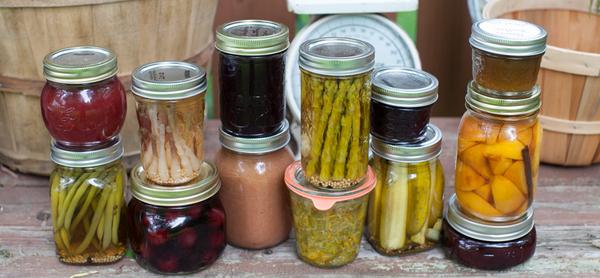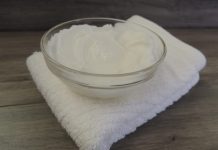Have you ever opened a can you had made a year ago and didn’t know whether it was rotten or not? Better to throw it away or simply remove it – the mold for example – and eat the rest? I can’t even recall how many times I came across in such a situation.
Eating spoiled canned goods will lead to death for those of you who don’t know!
Especially a bacterium called Clostridium Botulinum that produces a toxin that causes botulism in canned foods – a deadly type of food poisoning. This is also the most highly lethal toxin known: only one teaspoonful is necessary to kill 100,000 people. Improper home canning provides the ideal environment for botulism bacteria to grow. Also if the chances are slim, the results are catastrophic. Please feel free to share this knowledge. You can save a life without having even known it.
The botulism spores are heat-resistant and can survive in foods that are incorrectly processed, and are difficult to destroy. While high cooking temperatures will destroy the bacteria, killing the spores requires even higher temperatures. Which is why a pressure canner is used for the canning of low-acid foods. When in the canning cycle, the spores aren’t destroyed, they can again become normal cells and develop the deadly toxin.
Testing Jar Seals


1. Press the middle of the lid with a finger or thumb. If the lid springs up when you release your finger, the lid is unsealed.
2. You can also tap the lid with the bottom of a teaspoon. A clear ringing sound means a good seal. If it makes a dull sound, the lid is not properly sealed. If food is in contact with the underside of the lid, it will also cause a dull sound (that is neither a problem nor a sign of spoilage).
3. Hold the jar at eye level and look across the lid. The lid should be concave (curved down slightly in the center). If the center of the lid is either flat or bulging, it may not be sealed.
You should never eat food from a can with bulging ends. Bulging is one of several clues that might indicate contamination of food packaged in cans and jars.
Related: Best Canned Cheese For Emergency Survival
Inspecting the Jar or Can (before opening it)
Bulges, dents near the ends of the can, a leak from anywhere in the can, a crack in the glass of the jar and RUST (for jars – rust on the margins of the lid) are reasons to toss out cans automatically. This can allow air in and bacteria will start to develop. Some bacteria may cause the so-called “flat-sour” spoilage; essentially, the bacteria allow the food to spoil without producing any gases. So the can look just good on the outside but the food is poisoned inside.
Cloudiness – Dilemma (throw or eat?)
Cloudiness isn’t just about the food has been spoiled. Cloudiness also goes hand in hand with flat sour spoilage but you can also sense a bad smell. If the liquid is thick, or if you are uncertain how the food was prepared, boil the food 10 minutes before you taste it. If during boiling the food doesn’t smell natural, throw it away without tasting. Typically, the cloudiness would be very noticeable in spoiled foods.
Cloudiness can not lead to spoilage of other foods. For example, the starch content can cause cloudiness in over mature peas and many kinds of dry beans. Uneven sizing of products can also cause cloudiness. Small tender peas, for example, can cook to bits during heat processing, while more mature peas will maintain their shape in the same way. Under these conditions, the liquid will get quite cloudy.
Hard water or salt which contains impurities or additives may cause cloudiness in home-canned foods. In fruits, over-ripe fruit may make the syrup cloudy. Fermentation allows the liquid to turn opaque over brined dill pickles. Cloudiness is common in all of these cases, and not harmful.
After and while Opening the Lid or the Can
For glass jars – a pop-top that does not pop when opened (loss of the vacuum) = a damaged seal – Throw away!
Mold – Dilemma (Scrape the moldy parts and eat what isn’t moldy? OR throw away everything?)
My mother always scraped the moldy parts that were over the jams, and we ate the content. I had never had a problem. And I’m still doing that (with jams only).
BUT my mind tells me there must have been still the mold because all the molds die in the boiling process.
And in certain extreme bacteria it may have gotten along with the mold that you absolutely cannot identify. And my advice to anyone who asks is: Throw it away!
Personally, I just scrap the moldy bits for jams – because jams cannot develop Botulinum bacteria (almost all FRUITS have enough natural acidity to protect us against the risk of botulism).
In reality, jams are typically so secure that June Taylor, who is a very respected preserver (in Berkeley, California), says: “The only way you can damage someone with a jam is by cracking them with it in the head.”
Smelling Dilemma
I’m sure there are a few people out there who still sniff it to see if it went bad – despite knowing that the bottle has mold. That’s not a good idea because all the air around the mold is full of spores; spores that are inhaled in your lungs can cause allergies, and even some serious things.
If the food doesn’t have any molds on the surface, smell it. When it gets bad … you’ll know that. I can’t tell you exactly the smell of a spoiled canned food, because it’s different from one jar to another – but it’s really bad.
Botulinum bacteria are one of the few that is odorless and can’t be seen, you can’t always tell which jars are contaminated. The only things you can search for are clear signs of sealing and swelling. If you think food is spoiled on a bottle or bowl, never, never taste it.
It’s really not much to say about the taste: if it has the taste it should: eat it. If not, throw it away.
It is tempting to take shortcuts sometimes, but it’s not worth the risk when canning. If spoilage microorganisms are not killed, canned goods are unhealthy, and can have serious consequences.
Related: How Do You Know if a Canning Recipe is Safe
Is it safe to use jars or cans that have frozen accidentally?
Cans or jars that freeze accidentally, such as those left in a car or basement in sub-zero temperatures, can present health problems.
Because the food inside expands when frozen, the pressure inside the jar will rise. When this happens the lid might get air inside. Not very safe to eat!
Do crystals in canned goods mean the food is not safe?
Canned food (usually seafood) often contains tiny pieces of a glass-like material. According to the U.S. Food and Drug Administration (FDA), these crystals pose no danger to consumers. Chemically known as magnesium ammonium phosphate, commonly called “struvite,” the crystals that form from some of the fish or shellfish’s natural constituents after they are commercially canned.
Can Pickles have Botulimia Bacteria?
Pickles are somewhat different because pickles work with vegetables, and vegetables are low-acid – which means they may develop Botulimia. But a pickle is a vegetable that has been covered with acidified brine, and that acid can either come from vinegar, that’s what we call a vinegar pickle or a quick pickle, or the acidity can be achieved through fermentation. This is to say, the fermentation cycle produces enough acidity to eliminate the possibility of botulism thanks to the wonderful processes of this micro-environment in which official lactobacillus bacteria are doing their thing.
If I’m not sure about one… What if I boil the jar or the can before eating it, just to make sure?
No. This can help to remove most harmful items, but not the worst (botulimia). To destroy the bacteria, you can cook it out but it’s not the bacteria that will kill you. It is the toxin it leaves behind.
What jars are best for canning?
It’s necessary to use heavy duty jars that are made specifically for home canning.
The most popular option is “Mason” type jars, which are screwed shut with a threaded neck. Do not re-use the lids, after a lid has been pried off once a perfect fit can no longer be guaranteed. Several times, the jars themselves can be used, as long as the rims are perfectly smooth and there are no marks or cracks to prevent a full seal.
Do not use commercial jars, for home canning, such as empty peanut butter jars. Commercial jars are not large enough to be used safely. Although most of the times – it works.
Related: 12 Essential Food to Stockpile Before Its Off the Shelves
Is it safe to eat canned foods that went through a flooding?
Contaminated bottles, after contact with water, may be a concern. Floodwater can contain sewage and waste from animals, oil, and other contaminants, including agricultural and industrial chemicals. The Food and Drug Administration ( FDA) advises throwing out anything that is not kept in a safe container after a storm, if there is a chance of contact.





















